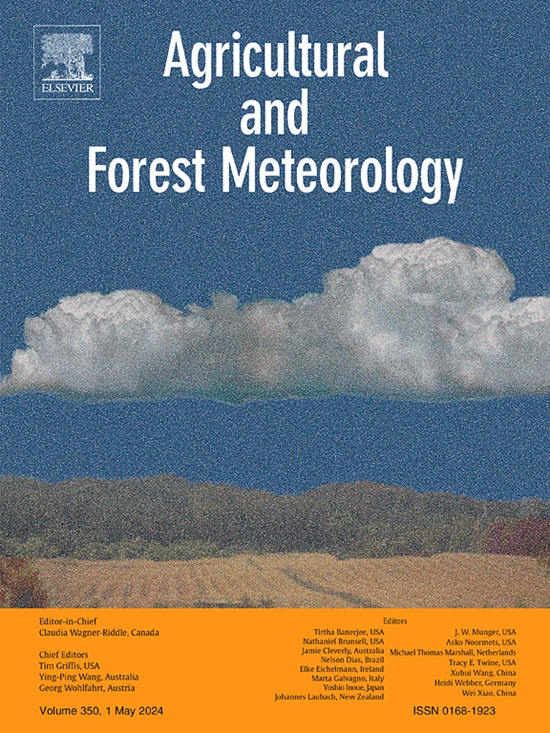A lightweight SIF-based crop yield estimation model: A case study of Australian wheat
IF 5.6
1区 农林科学
Q1 AGRONOMY
引用次数: 0
Abstract
As Australia's primary staple and export crop, wheat necessitates reliable yield mapping to ensure timely alerts about food insecurity. Conventional crop yields are estimated using either process-based or statistical models, but both face challenges in large-scale application due to the extensive data required. Recent studies have shown that the gross primary production (GPP) of plants can be mechanistically estimated from the fraction of open PSII reaction centers (qL), solar-induced chlorophyll fluorescence (SIF), and readily accessible meteorological datasets including air temperature (Tair), dew-point temperature, and soil water content. qL can be modeled as a function of SIF and Tair. Along with these theoretical advances, the resolution of satellite SIF has greatly improved, boosting the potential for accurate large-scale crop yield estimation. In this study, we develop a SIF-based lightweight crop model which uses qL and SIF to track crop GPP. This approach allows for a direct mechanistic estimation of GPP without the need to explicitly account for numerous complex agro-climatic processes. We apply this model to estimate Australian wheat yields from 2019 to 2022. The model exhibits strong predictive power, explaining 86 % of wheat production variance at the regional level (RMSE: 91 kilotons, rRMSE: 7.24 %) and 91 % at the state level (RMSE: 1509 kilotons, rRMSE: 14.13 %). Australian wheat yields exhibit a positive correlation with soil water content and vapor pressure deficit (VPD) when VPD remains below 0.80 kPa. However, the correlation turns negative once VPD exceeds this threshold. We also identify the main sources of error in estimating wheat production as: (1) inaccuracies in estimating the harvested area of wheat, and (2) the relatively low spatial resolution of current satellite SIF data. Our model, with its lightweight design and its ability to mechanistically estimate crop photosynthetic CO2 assimilation, offers a promising, novel framework for practical, large-scale crop yield mapping.
一个轻量级的基于sif的作物产量估算模型:以澳大利亚小麦为例
作为澳大利亚的主要粮食和出口作物,小麦需要可靠的产量地图,以确保及时发出粮食不安全警报。传统的作物产量估计要么使用基于过程的模型,要么使用统计模型,但由于需要大量的数据,这两种模型在大规模应用时都面临挑战。最近的研究表明,植物的总初级生产量(GPP)可以通过开放的PSII反应中心(qL)的比例、太阳诱导的叶绿素荧光(SIF)和容易获得的气象数据集(包括气温(Tair)、露点温度和土壤含水量)进行机械估算。qL可以建模为SIF和Tair的函数。随着这些理论的进步,卫星SIF的分辨率有了很大的提高,提高了精确的大规模作物产量估计的潜力。在本研究中,我们开发了一个基于SIF的轻量级作物模型,该模型使用qL和SIF来跟踪作物GPP。这种方法允许对GPP进行直接的机制估计,而不需要明确地考虑许多复杂的农业气候过程。我们将该模型应用于2019年至2022年澳大利亚小麦产量的估算。该模型具有较强的预测能力,可以解释86%的区域小麦产量差异(RMSE: 91千吨,rRMSE: 7.24%)和91%的州小麦产量差异(RMSE: 1509千吨,rRMSE: 14.13%)。当土壤水汽压亏缺(VPD)低于0.80 kPa时,澳大利亚小麦产量与土壤含水量和VPD呈正相关。然而,一旦VPD超过这个阈值,相关性变为负相关。我们还指出了估算小麦产量的主要误差来源:(1)估算小麦收获面积的不准确;(2)当前卫星SIF数据的空间分辨率相对较低。我们的模型具有轻量化设计和机械估算作物光合CO2同化的能力,为实际的大规模作物产量测绘提供了一个有希望的新框架。
本文章由计算机程序翻译,如有差异,请以英文原文为准。
求助全文
约1分钟内获得全文
求助全文
来源期刊
CiteScore
10.30
自引率
9.70%
发文量
415
审稿时长
69 days
期刊介绍:
Agricultural and Forest Meteorology is an international journal for the publication of original articles and reviews on the inter-relationship between meteorology, agriculture, forestry, and natural ecosystems. Emphasis is on basic and applied scientific research relevant to practical problems in the field of plant and soil sciences, ecology and biogeochemistry as affected by weather as well as climate variability and change. Theoretical models should be tested against experimental data. Articles must appeal to an international audience. Special issues devoted to single topics are also published.
Typical topics include canopy micrometeorology (e.g. canopy radiation transfer, turbulence near the ground, evapotranspiration, energy balance, fluxes of trace gases), micrometeorological instrumentation (e.g., sensors for trace gases, flux measurement instruments, radiation measurement techniques), aerobiology (e.g. the dispersion of pollen, spores, insects and pesticides), biometeorology (e.g. the effect of weather and climate on plant distribution, crop yield, water-use efficiency, and plant phenology), forest-fire/weather interactions, and feedbacks from vegetation to weather and the climate system.

 求助内容:
求助内容: 应助结果提醒方式:
应助结果提醒方式:


